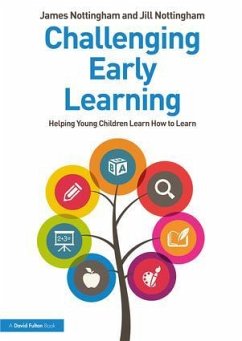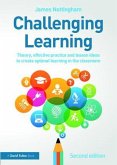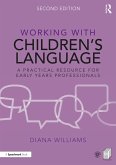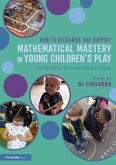James Nottingham, Jill Nottingham
Challenging Early Learning
Helping Young Children Learn How to Learn
James Nottingham, Jill Nottingham
Challenging Early Learning
Helping Young Children Learn How to Learn
- Broschiertes Buch
- Merkliste
- Auf die Merkliste
- Bewerten Bewerten
- Teilen
- Produkt teilen
- Produkterinnerung
- Produkterinnerung
This book takes James Nottingham's tried and tested and acclaimed 'learning to learn' methodology and applies it to teaching 3-7 year olds. Nottingham identifies the ways adults can help children in early years settings utilise feedback, challenge, dialogue, growth mindset, and the Learning Pit.
Andere Kunden interessierten sich auch für
![Challenging Learning Challenging Learning]() James NottinghamChallenging Learning52,99 €
James NottinghamChallenging Learning52,99 €![Working with Children's Language Working with Children's Language]() Diana WilliamsWorking with Children's Language66,99 €
Diana WilliamsWorking with Children's Language66,99 €![So... What Does an Outstanding Teacher Do? So... What Does an Outstanding Teacher Do?]() Cat ChowdharySo... What Does an Outstanding Teacher Do?30,99 €
Cat ChowdharySo... What Does an Outstanding Teacher Do?30,99 €![Visible Learning: The Sequel Visible Learning: The Sequel]() John Hattie (University of Melbourne)Visible Learning: The Sequel23,99 €
John Hattie (University of Melbourne)Visible Learning: The Sequel23,99 €![Visible Learning: The Sequel Visible Learning: The Sequel]() John Hattie (University of Melbourne)Visible Learning: The Sequel165,99 €
John Hattie (University of Melbourne)Visible Learning: The Sequel165,99 €![How to Recognise and Support Mathematical Mastery in Young Children's Play How to Recognise and Support Mathematical Mastery in Young Children's Play]() How to Recognise and Support Mathematical Mastery in Young Children's Play40,99 €
How to Recognise and Support Mathematical Mastery in Young Children's Play40,99 €![The Outdoor Classroom Ages 3-7 The Outdoor Classroom Ages 3-7]() Karen Constable (Teacher, Mark First School, UK)The Outdoor Classroom Ages 3-745,99 €
Karen Constable (Teacher, Mark First School, UK)The Outdoor Classroom Ages 3-745,99 €-
-
-
This book takes James Nottingham's tried and tested and acclaimed 'learning to learn' methodology and applies it to teaching 3-7 year olds. Nottingham identifies the ways adults can help children in early years settings utilise feedback, challenge, dialogue, growth mindset, and the Learning Pit.
Hinweis: Dieser Artikel kann nur an eine deutsche Lieferadresse ausgeliefert werden.
Hinweis: Dieser Artikel kann nur an eine deutsche Lieferadresse ausgeliefert werden.
Produktdetails
- Produktdetails
- Verlag: Taylor & Francis Ltd
- Seitenzahl: 194
- Erscheinungstermin: 20. Mai 2019
- Englisch
- Abmessung: 287mm x 207mm x 15mm
- Gewicht: 632g
- ISBN-13: 9780367027650
- ISBN-10: 0367027658
- Artikelnr.: 56863863
- Herstellerkennzeichnung
- Libri GmbH
- Europaallee 1
- 36244 Bad Hersfeld
- gpsr@libri.de
- Verlag: Taylor & Francis Ltd
- Seitenzahl: 194
- Erscheinungstermin: 20. Mai 2019
- Englisch
- Abmessung: 287mm x 207mm x 15mm
- Gewicht: 632g
- ISBN-13: 9780367027650
- ISBN-10: 0367027658
- Artikelnr.: 56863863
- Herstellerkennzeichnung
- Libri GmbH
- Europaallee 1
- 36244 Bad Hersfeld
- gpsr@libri.de
James and Jill Nottingham started an educational company in 1999 to support local nurseries and schools with the development of Philosophy for Children. This evolved into a multimillion-pound social regeneration project to raise the aspirations and abilities of young people in North East England. With the success of this project, early childhood centres across Scandinavia, Australia and New Zealand wanted to get involved in the Nottinghams' award-winning approaches to challenge, dialogue, feedback, questioning and progress. To meet this demand, Jill and James set up companies in Australia, Denmark, Norway, Sweden, the UK and the USA, and now employ 30 educational experts who lead, demonstrate and guide practitioners and parents in the best ways to enhance young children's learning.
Foreword Preface The Language of Learning Chapter 1: Creating the
Conditions for Early Learning 1.0 Challenging Early Learning 1.1
Encouraging Growth in A Nursery 1.2 Learning How to Learn 1.3 The ASK Model
1.4 ASK Model: Attitudes 1.4.1 The Marshmallow Experiment 1.5 ASK Model:
Skills 1.6 Learning Detectives 1.7 Chapter Summary Chapter 2: Children's
Response to Challenge 2.0 Which Path Would You Choose? 2.1 Why Do Children
Pick the Easier Path? 2.2 Persuading Children Out of Their Comfort Zone 2.3
The Learning Challenge 2.4 Learning Challenge Stage 1: Identify Concepts
2.5 Learning Challenge Stage 2: Creative Cognitive Conflict 2.5.1 Wobblers
2.5.2 Comparisons 2.5.3 Prepared Questions 2.6 Learning Challenge Stage 3:
Construct Understanding 2.6.1 Concept Targets 2.6.2 Ranking 2.6.3 Venn
diagrams 2.6.4 Opinion Lines 2.6.5 Opinion Corners 2.7 Learning Challenge
Stage 4: Consider the Learning 2.8 Chapter Summary Chapter 3: Developing
Dialogue with Young Children 3.0 Using Dialogue to Develop Children's
Language 3.1 Different Types of Talk 3.2 Cumulative Talk 3.3 Disputational
Talk 3.4 Exploratory Talk 3.5 Encouraging Exploratory Talk 3.6 Repeating,
Reflecting, Rephrasing, and Extending 3.7 Chapter Summary Chapter 4:
Engaging Children's Thinking Skills 4.0 Learning How to Think 4.1
Transporter 4.2 Odd One Out 4.3 That Is What I Was Thinking 4.4 The Three
Whys (Men) 4.5 A Reasonable Holiday 4.6 What If? 4.7 Storyboarding 4.8
Fortunately; Unfortunately 4.9 Chapter Summary Chapter 5: Listening,
Thinking and Questioning 5.0 Patience for Listening 5.1 Trust and Respect
5.2 Listening and Thinking (rather than Listening and Talking) 5.3
Developing Questioning 5.4 Open Questions 5.5 Socratic Questions 5.6 Who,
What, Where, When, Why, How 5.7 Question Stems 5.8 Thinking Progress 5.9
Chapter Summary Chapter 6: Making Progress 6.0 Focus on Progress 6.1
Progress in Terms of The SOLO Taxonomy 6.2 The SOLO Taxonomy and Learning
6.3 The SOLO Taxonomy and The Learning Challenge 6.4 Progress and a Growth
Mindset 6.5 Mindset and Praise 6.6 Ways to Praise 6.7 Other Ways to Build a
Growth Mindset 6.8 Self Efficacy 6.9 Chapter Summary Chapter 7: Feedback
and Learning Goals 7.0 The Impact of Feedback 7.1 What Is Feedback? 7.2
Feedback and Praise 7.3 Learning Goals and Feedback 7.4 Timing 7.5 Sitting
Beside Your Children 7.6 Encouraging the Right Type of Feedback 7.7 Seven
Steps to Feedback Success 7.8 The Seven Steps to Feedback - Some Final
Thoughts 7.9 Chapter Summary Chapter 8: Early Learning Activities Activity
1: What Is a Toy? Activity 2: People Who Help Us Activity 3: The
Gingerbread Man Activity 4: Why Is Teddy Feeling Unwell? Activity 5:
Decisions, Decisions Activity 6: Shape Activity 7: Fairy Tales Activity 8:
Being A Good Friend Appendix 1 Coded Transcript Relating to Section 3.6
Conditions for Early Learning 1.0 Challenging Early Learning 1.1
Encouraging Growth in A Nursery 1.2 Learning How to Learn 1.3 The ASK Model
1.4 ASK Model: Attitudes 1.4.1 The Marshmallow Experiment 1.5 ASK Model:
Skills 1.6 Learning Detectives 1.7 Chapter Summary Chapter 2: Children's
Response to Challenge 2.0 Which Path Would You Choose? 2.1 Why Do Children
Pick the Easier Path? 2.2 Persuading Children Out of Their Comfort Zone 2.3
The Learning Challenge 2.4 Learning Challenge Stage 1: Identify Concepts
2.5 Learning Challenge Stage 2: Creative Cognitive Conflict 2.5.1 Wobblers
2.5.2 Comparisons 2.5.3 Prepared Questions 2.6 Learning Challenge Stage 3:
Construct Understanding 2.6.1 Concept Targets 2.6.2 Ranking 2.6.3 Venn
diagrams 2.6.4 Opinion Lines 2.6.5 Opinion Corners 2.7 Learning Challenge
Stage 4: Consider the Learning 2.8 Chapter Summary Chapter 3: Developing
Dialogue with Young Children 3.0 Using Dialogue to Develop Children's
Language 3.1 Different Types of Talk 3.2 Cumulative Talk 3.3 Disputational
Talk 3.4 Exploratory Talk 3.5 Encouraging Exploratory Talk 3.6 Repeating,
Reflecting, Rephrasing, and Extending 3.7 Chapter Summary Chapter 4:
Engaging Children's Thinking Skills 4.0 Learning How to Think 4.1
Transporter 4.2 Odd One Out 4.3 That Is What I Was Thinking 4.4 The Three
Whys (Men) 4.5 A Reasonable Holiday 4.6 What If? 4.7 Storyboarding 4.8
Fortunately; Unfortunately 4.9 Chapter Summary Chapter 5: Listening,
Thinking and Questioning 5.0 Patience for Listening 5.1 Trust and Respect
5.2 Listening and Thinking (rather than Listening and Talking) 5.3
Developing Questioning 5.4 Open Questions 5.5 Socratic Questions 5.6 Who,
What, Where, When, Why, How 5.7 Question Stems 5.8 Thinking Progress 5.9
Chapter Summary Chapter 6: Making Progress 6.0 Focus on Progress 6.1
Progress in Terms of The SOLO Taxonomy 6.2 The SOLO Taxonomy and Learning
6.3 The SOLO Taxonomy and The Learning Challenge 6.4 Progress and a Growth
Mindset 6.5 Mindset and Praise 6.6 Ways to Praise 6.7 Other Ways to Build a
Growth Mindset 6.8 Self Efficacy 6.9 Chapter Summary Chapter 7: Feedback
and Learning Goals 7.0 The Impact of Feedback 7.1 What Is Feedback? 7.2
Feedback and Praise 7.3 Learning Goals and Feedback 7.4 Timing 7.5 Sitting
Beside Your Children 7.6 Encouraging the Right Type of Feedback 7.7 Seven
Steps to Feedback Success 7.8 The Seven Steps to Feedback - Some Final
Thoughts 7.9 Chapter Summary Chapter 8: Early Learning Activities Activity
1: What Is a Toy? Activity 2: People Who Help Us Activity 3: The
Gingerbread Man Activity 4: Why Is Teddy Feeling Unwell? Activity 5:
Decisions, Decisions Activity 6: Shape Activity 7: Fairy Tales Activity 8:
Being A Good Friend Appendix 1 Coded Transcript Relating to Section 3.6
Foreword Preface The Language of Learning Chapter 1: Creating the
Conditions for Early Learning 1.0 Challenging Early Learning 1.1
Encouraging Growth in A Nursery 1.2 Learning How to Learn 1.3 The ASK Model
1.4 ASK Model: Attitudes 1.4.1 The Marshmallow Experiment 1.5 ASK Model:
Skills 1.6 Learning Detectives 1.7 Chapter Summary Chapter 2: Children's
Response to Challenge 2.0 Which Path Would You Choose? 2.1 Why Do Children
Pick the Easier Path? 2.2 Persuading Children Out of Their Comfort Zone 2.3
The Learning Challenge 2.4 Learning Challenge Stage 1: Identify Concepts
2.5 Learning Challenge Stage 2: Creative Cognitive Conflict 2.5.1 Wobblers
2.5.2 Comparisons 2.5.3 Prepared Questions 2.6 Learning Challenge Stage 3:
Construct Understanding 2.6.1 Concept Targets 2.6.2 Ranking 2.6.3 Venn
diagrams 2.6.4 Opinion Lines 2.6.5 Opinion Corners 2.7 Learning Challenge
Stage 4: Consider the Learning 2.8 Chapter Summary Chapter 3: Developing
Dialogue with Young Children 3.0 Using Dialogue to Develop Children's
Language 3.1 Different Types of Talk 3.2 Cumulative Talk 3.3 Disputational
Talk 3.4 Exploratory Talk 3.5 Encouraging Exploratory Talk 3.6 Repeating,
Reflecting, Rephrasing, and Extending 3.7 Chapter Summary Chapter 4:
Engaging Children's Thinking Skills 4.0 Learning How to Think 4.1
Transporter 4.2 Odd One Out 4.3 That Is What I Was Thinking 4.4 The Three
Whys (Men) 4.5 A Reasonable Holiday 4.6 What If? 4.7 Storyboarding 4.8
Fortunately; Unfortunately 4.9 Chapter Summary Chapter 5: Listening,
Thinking and Questioning 5.0 Patience for Listening 5.1 Trust and Respect
5.2 Listening and Thinking (rather than Listening and Talking) 5.3
Developing Questioning 5.4 Open Questions 5.5 Socratic Questions 5.6 Who,
What, Where, When, Why, How 5.7 Question Stems 5.8 Thinking Progress 5.9
Chapter Summary Chapter 6: Making Progress 6.0 Focus on Progress 6.1
Progress in Terms of The SOLO Taxonomy 6.2 The SOLO Taxonomy and Learning
6.3 The SOLO Taxonomy and The Learning Challenge 6.4 Progress and a Growth
Mindset 6.5 Mindset and Praise 6.6 Ways to Praise 6.7 Other Ways to Build a
Growth Mindset 6.8 Self Efficacy 6.9 Chapter Summary Chapter 7: Feedback
and Learning Goals 7.0 The Impact of Feedback 7.1 What Is Feedback? 7.2
Feedback and Praise 7.3 Learning Goals and Feedback 7.4 Timing 7.5 Sitting
Beside Your Children 7.6 Encouraging the Right Type of Feedback 7.7 Seven
Steps to Feedback Success 7.8 The Seven Steps to Feedback - Some Final
Thoughts 7.9 Chapter Summary Chapter 8: Early Learning Activities Activity
1: What Is a Toy? Activity 2: People Who Help Us Activity 3: The
Gingerbread Man Activity 4: Why Is Teddy Feeling Unwell? Activity 5:
Decisions, Decisions Activity 6: Shape Activity 7: Fairy Tales Activity 8:
Being A Good Friend Appendix 1 Coded Transcript Relating to Section 3.6
Conditions for Early Learning 1.0 Challenging Early Learning 1.1
Encouraging Growth in A Nursery 1.2 Learning How to Learn 1.3 The ASK Model
1.4 ASK Model: Attitudes 1.4.1 The Marshmallow Experiment 1.5 ASK Model:
Skills 1.6 Learning Detectives 1.7 Chapter Summary Chapter 2: Children's
Response to Challenge 2.0 Which Path Would You Choose? 2.1 Why Do Children
Pick the Easier Path? 2.2 Persuading Children Out of Their Comfort Zone 2.3
The Learning Challenge 2.4 Learning Challenge Stage 1: Identify Concepts
2.5 Learning Challenge Stage 2: Creative Cognitive Conflict 2.5.1 Wobblers
2.5.2 Comparisons 2.5.3 Prepared Questions 2.6 Learning Challenge Stage 3:
Construct Understanding 2.6.1 Concept Targets 2.6.2 Ranking 2.6.3 Venn
diagrams 2.6.4 Opinion Lines 2.6.5 Opinion Corners 2.7 Learning Challenge
Stage 4: Consider the Learning 2.8 Chapter Summary Chapter 3: Developing
Dialogue with Young Children 3.0 Using Dialogue to Develop Children's
Language 3.1 Different Types of Talk 3.2 Cumulative Talk 3.3 Disputational
Talk 3.4 Exploratory Talk 3.5 Encouraging Exploratory Talk 3.6 Repeating,
Reflecting, Rephrasing, and Extending 3.7 Chapter Summary Chapter 4:
Engaging Children's Thinking Skills 4.0 Learning How to Think 4.1
Transporter 4.2 Odd One Out 4.3 That Is What I Was Thinking 4.4 The Three
Whys (Men) 4.5 A Reasonable Holiday 4.6 What If? 4.7 Storyboarding 4.8
Fortunately; Unfortunately 4.9 Chapter Summary Chapter 5: Listening,
Thinking and Questioning 5.0 Patience for Listening 5.1 Trust and Respect
5.2 Listening and Thinking (rather than Listening and Talking) 5.3
Developing Questioning 5.4 Open Questions 5.5 Socratic Questions 5.6 Who,
What, Where, When, Why, How 5.7 Question Stems 5.8 Thinking Progress 5.9
Chapter Summary Chapter 6: Making Progress 6.0 Focus on Progress 6.1
Progress in Terms of The SOLO Taxonomy 6.2 The SOLO Taxonomy and Learning
6.3 The SOLO Taxonomy and The Learning Challenge 6.4 Progress and a Growth
Mindset 6.5 Mindset and Praise 6.6 Ways to Praise 6.7 Other Ways to Build a
Growth Mindset 6.8 Self Efficacy 6.9 Chapter Summary Chapter 7: Feedback
and Learning Goals 7.0 The Impact of Feedback 7.1 What Is Feedback? 7.2
Feedback and Praise 7.3 Learning Goals and Feedback 7.4 Timing 7.5 Sitting
Beside Your Children 7.6 Encouraging the Right Type of Feedback 7.7 Seven
Steps to Feedback Success 7.8 The Seven Steps to Feedback - Some Final
Thoughts 7.9 Chapter Summary Chapter 8: Early Learning Activities Activity
1: What Is a Toy? Activity 2: People Who Help Us Activity 3: The
Gingerbread Man Activity 4: Why Is Teddy Feeling Unwell? Activity 5:
Decisions, Decisions Activity 6: Shape Activity 7: Fairy Tales Activity 8:
Being A Good Friend Appendix 1 Coded Transcript Relating to Section 3.6








